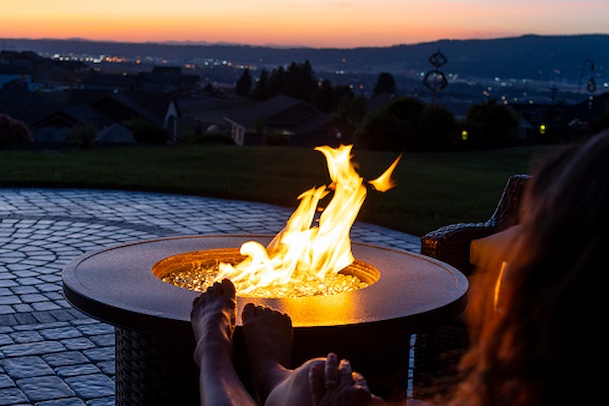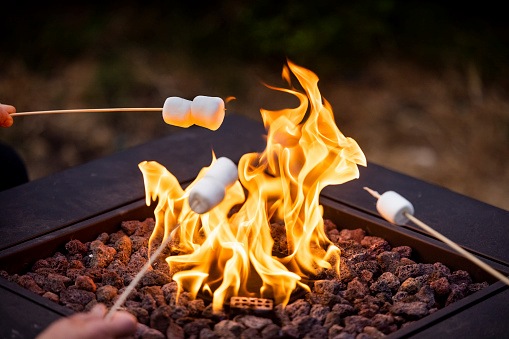
Do you adore the thought of a cozy fire in your backyard but detest having to deal with the smoke and soot? Traditional fire pits can be very enjoyable, but they also generate a lot of smoke and soot. It can be difficult to enjoy a fire without bringing odor, smokiness, or dirt into your house.
The ideal solution is a smokeless fire pit. You can enjoy a cozy fire without worrying that it will dirty your house because these pits don’t produce smoke or soot. Continue reading for a detailed explanation of what smokeless fire pits are, how they work, and the advantages and disadvantages of buying or building your own.
How Do Smokeless Fire Pits Work?
A smokeless fire pit’s technology is brilliant. The “fire triangle” theory forms the foundation of it. Manufacturers of smokeless fire pits assert that healthy fires include these three components: sufficient oxygen, ample heat, and quality fuel. When the trio-factor is reached, the fire can produce enough heat to extinguish itself without producing any smoke.
So, how do these man-made marvels operate? Let’s take a closer look at how design and functionality work together to create smokeless fire in order to comprehend why these amazing fire tools are referred to as smokeless.
You can enjoy a bonfire with no stress thanks to smokeless fire pits. However, be realistic in your expectations. Smokeless does not necessarily imply that something is entirely smoke-free. As the fuel burns, some smoke is produced. The sum is insignificant, though. You won’t even notice it, and the musty smoke odor won’t linger in your hair.
It’s normal to smoke when lighting the fuel (low moisture wood is ideal). But this only occurs initially. The combustible material is secondary burned after burning for roughly 10 to 20 minutes, producing heat energy.
At the base of the fire pit, the design incorporates a distinctive airflow system. By doing this, primary combustion will have sufficient oxygen.
The smoke is burned as it leaves the fire pit at the same time that double-walled convection pulls air up through the walls. It’s secondary combustion right now. A fire pit without smoke is the end result.
The air around the logs is heated by the enlarging fire after the firewood or wood pellets are placed in the pit and set on fire, causing primary combustion.
The fire intensifies as the wood burns. Because there is more airflow here than in conventional fire pits, this is different. When a fire lacks oxygen, it cannot burn its fuel completely, resulting in soot and dense smoke. Fires require oxygen for combustion.
Secondary combustion follows. The magic happens here. As the fire burns, the walls warm up, which causes the hot air trapped between the two walls to lose density and start rising. The hot air then exits the wall cavity through numerous holes along the smokeless fire pit’s rim.
Primary combustion smoke is burned as a result of the reaction between the heated, compressed oxygen and the smoke. In light of this, you can enjoy a smokeless fire at any time.
Does Heat Emit From Smokeless Fire Pits?
Smokeless fire pits still produce heat even though there isn’t any smoke to be seen. The fire is very real and presents the same advantages and risks as a conventional fire pit. This enables you to roast hot dogs and warm your hands to your heart’s content.
But it’s crucial to follow the same fire safety precautions you would with a regular fire pit or campfire. For instance, keep a safe distance when sitting near the pit and don’t allow children to approach it unattended. Additionally, don’t set anything on the edge of the pit.
Can I Use A Smokeless Fire Pit When There Is A Burn Ban?
Occasionally, depending on the kind of burn ban in effect.
A smokeless fire pit is still burning wood with an open flame, so generally speaking, if there is a burn ban on campfires, that also applies to it. It might be acceptable to use a smokeless fire pit if the burn ban permits fires in designated campfire rings.
No matter where you are, whether it’s camping or in your backyard, it’s crucial to be aware of the regulations regarding burning. In addition to preventing wildfires, these regulations are in place to safeguard the quality of the air. Before starting any kind of fire, it is your responsibility to be aware of the laws that are currently in force in your neighborhood.
Can You Use A Smokeless Fire Pit On A Deck?
The manufacturers advise buying a fireproof pad to place under the fire pit if you plan to use it on a deck or other flammable surface. You could also place it on a patio or put something you made out of metal or rock underneath it.
If you plan to use the fire pit on a deck, I also advise purchasing a spark screen because it will stop sparks from flying out of the fire pit.
How To Build A Smokeless Fire Pit
Take a 55-gallon steel drum (a food-grade oil drum with a sealed lid) and cut it laterally into two halves (making the bottom half four inches higher than the top half).
Having two sturdy barrels with sealed ends is now possible.
The inversion occurs right now! When the barrel’s base is removed to make room for the fire pit and four legs are fashioned to serve as the base vent for primary and secondary combustion, the bottom half of the barrel will serve as the outer shell and top of the smokeless fire pit.
The base of the portable fire pit will be made out of what was the barrel’s sealed lid.
The barrel’s top portion becomes the interior wall of the fire pit when the lid is taken off.
Cutting the top half of the barrel down its length and overlapping the steel edges by three-quarters of an inch (and riveting them together) will effectively reduce the barrel’s diameter to create an ideal thermodynamic cavity between the inner and outer wall of the fire pit.
Inside the older, larger barrel is the new, smaller barrel. Under the lip of what once served as the oil drum’s bottom, it is riveted and sealed.
The inner wall of the smaller barrel is punctured with a series of one-half-inch holes. These holes will provide the heated air needed for secondary combustion.
Pros and Cons of Smokeless Fire Pits
Pros
As claimed, they produce a lot less smoke than a standard fire pit.
The majority of smokeless fire pits feature strong ventilation capabilities due to their design, which makes it simpler to ignite a fire in the first place.
Cons
While the temperature is much higher, you’ll need to swarm in a little closer to feel the warmth because the super-heated fire sends more heat up than out.
And compared to a traditional fire pit of comparable size, a smokeless fire pit purchased from a store will cost you a lot more. The enhanced, smoke-free experience is still a great value, and if you want to save money, you can always do it yourself.
Do you adore the thought of a cozy fire in your backyard but detest having to deal with the smoke and soot? Traditional fire pits can be very enjoyable, but they also generate a lot of smoke and soot. It can be difficult to enjoy a fire without bringing odor, smokiness, or dirt into your house.
The ideal solution is a smokeless fire pit. You can enjoy a cozy fire without worrying that it will dirty your house because these pits don’t produce smoke or soot. Continue reading for a detailed explanation of what smokeless fire pits are, how they work, and the advantages and disadvantages of buying or building your own.

Does Heat Emit From Smokeless Fire Pits?
Smokeless fire pits still produce heat even though there isn’t any smoke to be seen. The fire is very real and presents the same advantages and risks as a conventional fire pit. This enables you to roast hot dogs and warm your hands to your heart’s content.
But it’s crucial to follow the same fire safety precautions you would with a regular fire pit or campfire. For instance, keep a safe distance when sitting near the pit and don’t allow children to approach it unattended. Additionally, don’t set anything on the edge of the pit.
How To Build A Smokeless Fire Pit
Take a 55-gallon steel drum (a food-grade oil drum with a sealed lid) and cut it laterally into two halves (making the bottom half four inches higher than the top half).
Having two sturdy barrels with sealed ends is now possible.
The inversion occurs right now! When the barrel’s base is removed to make room for the fire pit and four legs are fashioned to serve as the base vent for primary and secondary combustion, the bottom half of the barrel will serve as the outer shell and top of the smokeless fire pit.
The base of the portable fire pit will be made out of what was the barrel’s sealed lid.
The barrel’s top portion becomes the interior wall of the fire pit when the lid is taken off.
Cutting the top half of the barrel down its length and overlapping the steel edges by three-quarters of an inch (and riveting them together) will effectively reduce the barrel’s diameter to create an ideal thermodynamic cavity between the inner and outer wall of the fire pit.
Inside the older, larger barrel is the new, smaller barrel. Under the lip of what once served as the oil drum’s bottom, it is riveted and sealed.
The inner wall of the smaller barrel is punctured with a series of one-half-inch holes. These holes will provide the heated air needed for secondary combustion.
How To Choose A Smokeless Fire Pit
When searching for the ideal smokeless fire pit, there are plenty of options. Finding the right balance between price, fuel type, and portability is essential.
Cost
Size is the primary determinant of price. The cost of a fire pit increases as its diameter increases. A solo backpacker unit should cost at least $70, but more expensive smokeless fire pits can cost thousands of dollars. The price range of $300 to $600, however, is reasonable if you’re looking for a straightforward fire pit that can fit a group of four to five people.
Fuel Type
Solid fuel, such as wood logs, charcoal, or wood pellets, is burned in a smokeless fire pit. Although many models have the ability to burn different fuels, their airflow and clean-out are typically tailored to burn a single fuel. If you stick with the fuel the manufacturer suggests, you’ll experience the fewest headaches possible.
Conclusion
When it comes to reducing the amount of fuel used in a fire pit and the amount of smoke produced, smokeless fire pits are a great choice for homeowners. They are particularly suitable if you live in a location where smoke from your fire pit can easily float into your neighbor’s yard. So if you’re looking for a smoke-free alternative to your backyard fire, a smoke-free fire pit is your best choice
